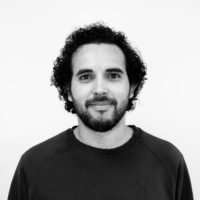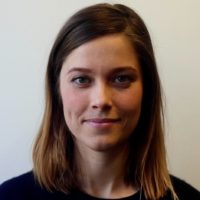Innovation
Award
Norway in Red, White, and Grey
Here stood rare trees, 150 years old.
This was a very important wetland...
...a wild reindeer area in the mountains...
...and a very important hundred acre forest for children, according to the Norwegian Environment Agency.
Every day we cut and blast just a little more...
...and a little more...
... and a little more.
This is the story of how we are sacrificing thousands of natural areas we have agreed to protect.
How we are failing our vulnerable environment, without realising it, without being able to stop.
The original publication of the project is embedded below. Underneath, find the full text.
It’s completely quiet in the wetland at Blefjell in Buskerud.
Håkon Gregersen has taken us to one of the most beautiful and important places he knows in Norwegian nature.
It’s just us and the birds out here in the magic mist. But then we hear sounds in the distance.
Construction machinery. Sawing.
Here at Blefjell there has been an unprecedented encroachment on the moors of Norway’s nature in recent years.
But nobody knows that.
Because in nature, no one sees the whole picture.
How do we Norwegians really take care of our nature? NRK has investigated this.
With the help of artificial intelligence, we have mapped all interventions into nature in Norway over the past five years. In collaboration with a leading expert in nature mapping, Zander Venter from the Norwegian Institute for Nature Research, we downloaded over 40,000 satellite images of our country. We then used artificial intelligence to analyse the images, looking for natural areas that had been developed between 2017 and 2022.
The result was a map of Norway full of spots, each representing a small piece of destroyed nature.
The AI didn’t pick up on forest roads, wind farms, or logging, nor did it detect underwater changes or ripple effects such as light pollution or noise.
Still, we found a lot of lost nature.
Look closely. Each square is an aerial photo of a construction site established in a nature area.
There are too many to show you all. 44,000 interventions—in just five years
So far, you’ve only scrolled through 1%.
This is the first time one can see how the entire natural landscape of Norway is being treated.
In nature, one small square metre can be home to tens of thousands of animals and plants, from the blackbird in the treetops to the bugs in the soil. In total, we sacrifice at least 79 such square metres per minute, the map shows.
These interventions are not part of any overarching plan. There is no budget for natural landscapes in Norway, no proper system of management. Each municipality says yes or no.
And when we started looking closer at the various sites, we quickly noticed something surprising:
Even some of the country’s largest environmental disruptions had gone completely under the radar.
The forest that was laid to waste
This is Lønnebakke, a hilly, lush forest area in Porsgrunn.
Or rather, this was Lønnebakke.
The pictures of the forest were taken by biologists from Biofokus, who documented its ecological riches six years ago.
They found green hills and hidden natural treasures. Ancient hollow oaks, ideal for endangered insects and fungi.
In Norway, 2,752 species are threatened with extinction, precisely because places like this are disappearing. That’s why the experts wrote detailed reports:
“Important.” “Important.” “Locally important.” “Locally important.” “Important.”
“Technical interventions and logging must/should be avoided.”
This is what it looked like then.
This is what it looks like now. Its new name is Grenlandsporten.
Or “one of Norway’s greenest business ventures,” as the project’s website calls it.
Around 500,000 square metres of forest, including seven areas of important oak forest, have been sacrificed to make room for a business park. The video only shows the top third of the area.
According to NRK‘s mapping, this is Norway’s eighth largest intervention in the last five years; only motorways, train lines and an airport were larger.
Yet there was silence before the first shovel hit the ground. The intervention was unanimously approved by the municipal council, without media discussion. Neighbours are supportive of the business park, while the Norwegian Society for Nature Conservation never realised how large the disruption would be.
The first company establishing itself there is a Burger King.
The authorities accepted that the forest could be cut down and blasted, as long as the most important hollow oaks were preserved.
Now, the ancient oaks stand on a lonely hill, cut off from their ecosystem.
It’s been five years since the surveyors were last here.
“They’ve sliced off the ridge,” says Sigve Reiso. “You can’t do anything worse to nature than this.”
“I feel a bitter taste in my mouth. Such massive destruction!”
John Gunnar Brynjulvsrud, Biofokus
The developer claims they have done everything by the book: reduced the area and preserved many important trees. They say they plan to plant greenery and facilitate energy wells, solar, and wind power.
Moreover, they point out, the area was already heavily impacted by the new E18 motorway and the Vestfold Line.
“In order to safeguard several valuable oaks, we’ve actually retained more green areas than required by the zoning plan.”
Project manager Erik Lønnebakke
Grenlandsporten is far from being an isolated case.
We travelled from north to south, from fjords to mountains, to see the changes with our own eyes. Everywhere we found construction: Motorways. Gravel pits. Housing developments. Wind farms.
We’ve spoken with young and old people alike. Here at Bunestoppen in Bamble, children can no longer enter their forest because someone decided to blow it up.
“They’re going to dig up the forest and build more houses,’” says ten-year-old Casper. “Then we won’t be able to play here anymore.”
Meanwhile, 79-year-old Arvid Andersen has seen Norway’s largest natural disruption, the E39 motorway, built right through his valley in Lohnelier, Sørlandet. Arvid’s trout stream is one of thousands of streams and rivers that have been directly affected by construction over the past five years, according to the survey. Now it’s underneath the motorway:
“I only drive the old road. I’m afraid I’ll have a heart attack if I see what it’s become,” says Arvid.
Even far offshore, amid isolated peaks and white sandy beaches, the sound of dynamite echoes.
The small islet to the right in the photo is called Lille Indre Rosøya.
When artificial intelligence signalled that something had been built on this islet, we initially thought it was mistaken.
The islet was in the middle of the Helgeland coast, one of Norway’s most beautiful and iconic landscapes.
But the AI was right. The islet was blown up—by the company owned by salmon farming billionaire Kjell Lorentsen.
More than a million salmon will live in the resulting basin. 2,700 tonnes of seawater will be pumped in every minute.
This is Kjell Lorentsen’s solution to the environmental problems in the aquaculture industry: move the fish onto land.
“Why are we doing this? To avoid salmon lice and escapes, and to purify the water on its way out. If we’re going to continue fish farming, we need to solve these problems.”
Kjell Lorentsen, Gigante Salmon
This is one of the largest interventions we found in a natural area defined as unspoiled, at least one kilometre away from any development. It is also located in the coastal zone.
The County Governor–responsible for halting environmentally damaging projects in Norway–was critical of the project but chose not to stop it.
Salmon farmer Lorentsen points out that there are still 300 islands left in the area. And the 15 jobs created at the facility can do a lot for the small, struggling local community.
“Yes, the intervention is large. But from a bird’s-eye view, it’s tiny!” he says.
“We have valuable and beautiful nature here, but should we protect every single island on the Nordland coast? How are people supposed to do anything up here then?”
Kjell Lorentsen, Gigante Salmon
It’s true—we need jobs, fish and roads.
And many of the 44,000 interventions we found have become important for society. You can see it in the before-and-after aerial photos:
This crucial frog pond …
… is now Stavanger University Hospital.
This patch of land near the coastal zone in Øygarden …
… has become a primary school and sports facility.
Besides, we have plenty of nature in Norway, don’t we?
Well, in a way, we do. Our country is so large that all the interventions identified in NRK‘s mapping correspond to less than a thousandth of Norway’s total area.
So, what’s the problem?
The issue is that there are types of nature of which we have very little left.
We humans have been building things for hundreds of years, so some types of nature have become rare and vulnerable:
Red-listed ecosystems, unspoilt nature, wetlands, riparian zones, watercourses and wild reindeer habitats.
These are home to many of our endangered plants and animals—and they need to be left alone. That’s why three prime ministers in a row have decided that municipalities should be extra careful with these important areas.
Surely, we can keep our fingers off the pot here?
No, we can’t. NRK can reveal today that building in these particularly valuable areas is literally an everyday occurrence.
The authorities do not have a full overview of development in these areas. But by cross-referencing the construction sites from NRK‘s investigation with various nature maps, we were able to document what they don’t know: that even here, in the centre of natural landscapes, new building sites are opened on average more than ten times a day.
On an average day, we destroy valuable nature in these areas equivalent to twice the size of the Ullevaal Stadium football field, according to our analysis.
We could list thousands of examples of interventions in the areas we have agreed to protect.
According to the Norwegian Environment Agency, these were “very important” flood plains, home to red-listed species…
… now it is a storage area for containers.
This was a critical forest for birds, with red-listed elm trees…
… it is now an indoor ski facility.
This was a vulnerable, high-quality natural pasture…
… now it’s home to a Coop and a Europris.
No matter which important areas we looked into, from wild reindeer habitats to coastal zones, we found millions of square metres of degraded nature.
And one thing stood out as the single biggest contributor to natural destruction in these valuable areas:
Cabins.
This is Blefjell, where we began this story. The environmental impact of construction here has received little attention because each cabin development is relatively small, and the expansion has happened bit by bit. No one has calculated the cumulative footprint of all the cabins, parking lots, and gravel roads.
But according to NRK‘s survey, the development of Blefjell is Norway’s largest wetland disruption in recent years.
Wetlands are full of carbon, which we don’t want to release as a greenhouse gas. They are also home to many of Norway’s vulnerable plants and animals. And here at Blefjell it’s especially wet.
In one of the wetlands on the mountain, wildlife ecologist Håkon Gregersen is despairing.
One of the most magical things Håkon knows about is the mating dance of the black grouse. “In this wetland, and the small area a few hundred metres around it, these birds—who are deeply tied to their habitat—have likely lived for hundreds of years,” Håkon says.
But: “Even here, new cabins have been built, right behind there,” Håkon sighs and points.
According to Håkon, this means that the black grouse will soon be gone from the area.
He looks around. Within the birds’ small habitat, he finds ditches and piles of dumped stones.
“The problem is that the degradation of nature is happening bit by bit. I don’t think we humans are quite able to react. It’s painful that our democracy can just let this happen,” says Håkon.
But here in the municipality there is a lot to gain from building cabins.
Oddvar Garås from the Centre Party, who was mayor during the period NRK investigated, says he is keen to protect nature.
At the same time, the development of cabins creates 150 to 200 full-time jobs in the municipality, Garås has calculated. “Without the cabins, the town would never have had two large supermarkets, a sports shop and a hotel.”
Moreover, he disagrees that they’re destroying so much wetland. He owns cabin land at Blefjell himself and argues that the wetland maps NRK used are inaccurate.
“I’ve done quite a lot of digging there myself, and the wetlands aren’t particularly deep,” he says.
In any case, he doesn’t think wetlands are as important as the experts and authorities would have us believe. “Wetlands are the only thing they’re concerned with these days. In a few years’ time, they’ll probably be interested in something else!”
NRK has been in contact with the developers and the municipalities behind all the projects mentioned in this story.
Behind every building site there is an explanation and a democratic decision. A rationale for why it was right to sacrifice nature in each particular case.
The story is the same for many of these interventions:
The municipalities have a lot to gain from the development.
The surrounding nature is already weakened by other interventions.
And no-one has a full overview.
And so, the degradation of nature happens bit by bit, without anyone seeing the full picture.
Climate and Environment Minister Andreas Bjelland Eriksen recognises that the authorities lack an overview of how we treat nature.
“NRK‘s mapping shows that we have failed to make nature the framework for our policies,” he says. “Developments are going in the wrong direction for nature. This is a serious societal issue.”
However, the minister has no plans to reduce municipal power in environmental matters, even after seeing NRK’s documentation. Instead, his primary solution is an accounting system for natural areas.
“I believe people in the municipalities are committed to preserving their own natural landscapes. The main challenge is that they don’t have a good enough overview,” says Bjelland Eriksen.
The government’s accounting system is set to be ready in its first version by 2026.
In the coming weeks, NRK will share more about where the system is failing.
In the meantime, we Norwegians continue to build.
Total nature lost while reading this story:
4,485 m² [constantly increasing figure, translator’s note].
Published 6 January 2024
Copyright NRK © 2024
Further Credits:
- Executive producer: Randi Helland
- Photo: Adrian Nielsen
- Photo: Snorre Tønset
- Aerial photo: Per Kåre Sandbakk
- Aerial photo: Jon Stabell Sauge
- Aerial photo: Alex Reitan
- Aerial photo: Harald Albrigtsen
- Design: Eirik Kirkaune
- Research: Kjell Erik Moen
- Research: Kent-Amar Eriksen
- Research: Astrid Engen











